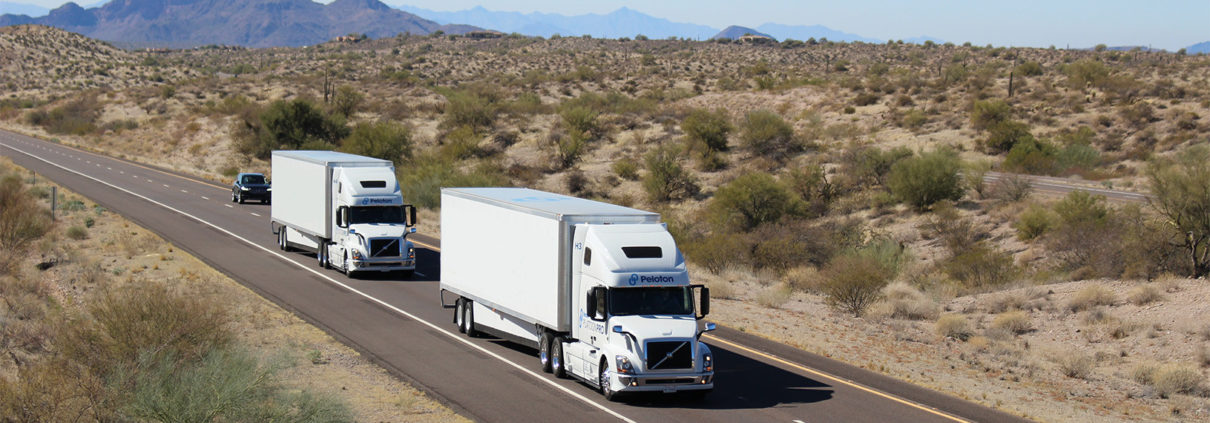Special Recognition: Peloton Technology: Truck Platooning with PlatoonPro
TRUCK PLATOONING WITH PLATOONPRO
by Stephen Boyd & Amanda F. Anderson, Peloton Technology
PROBLEM STATEMENT
Typical trucking operations have slim margins (an average of 6% in 20171 ), high fuels costs (fuel comprised ? 22% of total costs for an average trucking company in 20182), and the need to ensure safety (the number of large trucks involved in fatal crashes increased 10% from 2016 to 20173). Driver-Assistive Truck Platooning (DATP) can make trucking safer and more fuel efficient. DATP uses electronic vehicle-to-vehicle communication to connect advanced safety systems between pairs of trucks, allowing them to accelerate and brake as a single system, while reducing fuel consumption through safe aerodynamic drafting. The connected safety systems allow for a small gap between the two linked trucks—less than 60 feet. Similar to Adaptive Cruise Control, the follow truck driver has hands on the wheel and eyes on the road, but feet off the pedals. The lead driver continues to drive normally, controlling the platoon’s speed, and benefiting from collision avoidance always monitoring the road ahead.
Peloton Technology, Inc. has developed PlatoonPro, a DATP system that links pairs of heavy trucks for connected driving. When the lead truck brakes, the follow truck responds automatically in approximately one tenth of a second, significantly faster than a human driver’s reaction time. Peloton’s cloud-based system pre-maps a network of approved roads for platooning which includes multi-lane, divided, limited access highways. Platooning is automatically disabled outside this geofenced road network including in unsuitable platooning areas such as construction zones or on lower capacity bridges. Trained drivers can also relay safety information or coordinate lane changes through a dedicated push-to-talk radio link and a real-time video feed of the roadway ahead.
Fuel efficiency benefits of Peloton’s PlatoonPro average approximately 7.25%. Analysis has shown a 10% fuel savings for the follow truck and 4.5% fuel savings for the lead truck at a 40-foot gap and 65 mph4, bringing with them corresponding reductions in carbon emissions and other air pollutants. Safer than average American commercial trucks, platooning trucks are built on top of leading active truck safety technologies, including radar-based Forward Collision Avoidance Systems (FCAM) with Automatic Emergency Braking, Electronic Stability Control, Tractor Air Disc Brakes, and Trailer Anti-lock Braking Systems.
These systems can dramatically reduce the frequency and severity of truck rear-end collisions—a Con-way study found a 71 percent reduction in rear-end collisions for trucks equipped with FCAM5—but can cost thousands of dollars upfront. DATP’s fuel savings provide an economic incentive for fleets to adopt these platoon-required advanced safety features.
State following-distance laws can pose a barrier to commercial deployment of truck platooning. In about half of all U.S. states, a numeric following-distance for commercial vehicles—ranging from 100 to 500 feet—is found in statute, most based on an assessment of the ability of human-only driving operations. A uniformity of state following-distance laws would allow for DATP and help to optimize interstate commerce. The U.S. National Renewable Energy Laboratory determined that ? 65% of total miles driven by commercial trucks could be in platoon formation6. Higher utilization rates are expected for long/ regional haul trucks that operate mostly on-highway. If remaining state close following statutes are revised to consider DATP, states could see significant safety and environmental benefits. Concurrently, freight carriers’ cost of moving goods would decline, with savings potentially passed on to consumers.
2019 Better Government Comp… by Pioneer Institute on Scribd
REFERENCES
- Biery, Mary Ellen. “Trucking Companies Hauling in Higher Sales.” Forbes, Forbes Magazine, 4 Mar. 2018, www.forbes.com/sites/ sageworks/2018/03/04/ trucking-companieshauling-in-highersales/#644c7ac23f27.
- Hooper, Alan, and Dan Murray. An Analysis of the Operational Costs of Trucking: 2018 Update. American Transportation Research Institute, 2018, An Analysis of the Operational Costs of Trucking: 2018 Update, atri-online.org/wpcontent/uploads/2018/10/ ATRI-Operational-Costs-ofTrucking-2018.pdf.
- United States, U.S. Department of Transportation, Federal Motor Carrier Safety Administration, Analysis Division. “Large Truck and Bus Crash Facts 2017.” Mar. 2019. www.fmcsa.dot.gov/ sites/fmcsa.dot.gov/files/ docs/safety/data-andstatistics/452366/ltcbf-2017- early-release-3-13-2019. pdf#page=18.
- Roberts, Jack, et al. Confidence Report on Two -Truck Platooning. North American Council for Freight Efficiency, 2016, pp. 37–38, Confidence Report on Two -Truck Platooning
- United States, National Transportation Safety Board, “The Use of Forward Collision Avoidance Systems to Prevent and Mitigate Rear-End Crashes.” May 2015 https:// www.ntsb.gov/safety/safetystudies/Documents/SIR1501. Pdf
- Lammert, M.P., Bugbee, B., Hou, Y., Mack, A. et al., “Exploring Telematics Big Data for Truck Platooning Opportunities,” SAE Technical Paper 2018-01- 1083, 2018, doi:10.4271/2018- 01-1083. https://www.nrel.gov/ docs/fy18osti/70869.pdf




Leave a Reply
Want to join the discussion?Feel free to contribute!